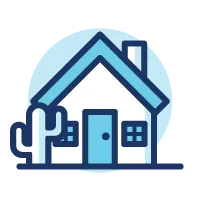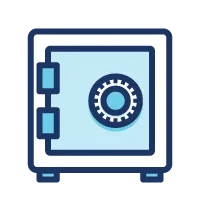What We'll Cover
- Strategies for paying off debt, including Debt Snowball, Debt Avalanche, and Debt Consolidation
- Pros and cons of each debt payoff strategy
- Debt Payoff Calculator
If you are currently facing an uphill battle on what seems like a mountain of debt, you are not alone.
A recent study by Northwestern Mutual reported adults in the United States who carry non-mortgage debt have an average $23,325 to pay off.
Not only are Americans trying to pay off debt as quickly as possible, but they’re also getting tackled from behind with high interest rates.
If you’re saddled by too much debt, we’ve got three ways that can help you quickly pay down your balance fast.
3 Ways to Pay Off Debt Faster
Here are three strategies to pay off your debt quickly.
1. Debt Snowball
The Debt Snowball method is a strategy to pay off debt in order of the smallest balance to the largest balance, while ignoring the interest rates.
How the Debt Snowball Debt Payoff Strategy Works
Step 1: List all your non-mortgage debt in order from smallest to largest balance, ignoring all interest rates.
Step 2: Make minimum payments on each debt on your list.
Step 3: Throw any extra dollars you possibly can at the smallest debt.
Step 4: When the smallest debt is paid in full, apply the amount you were paying towards the smallest debt to the next debt on your list.
Step 5: Rinse and repeat until all debt is paid off.
Why the Debt Snowball Debt Payoff Strategy Works
As you can see, the Debt Snowball ignores interest rates, which is why this method works so well.
Still not convinced?
Keep in mind the average credit card interest rate is just shy of 21%.
And since approximately 14 million Americans carry over a $10,000 balance on their credit cards each month, this tells us math isn’t the problem — it’s our behavior.
When you utilize the Debt Snowball method, you begin to change your behavior with money.
For most people facing debt, money is a constant stress in their lives and the one thing they haven’t felt in a long time is a financial win. However, when you line up your debts from smallest to largest and pay off that smallest one fast, you get a win.
After your first win, the snowball rolls over into the next debt and sooner than later you will have that one knocked out as well.
The debt snowball works so well because every time you pay off a debt, it builds hope, increases motivation, and helps you push through the last large and final debt until you reach debt freedom.
Debt Snowball
| Debt Balance | Minimum Monthly Payment |
|---|---|
| $1,500 Credit Card | $60 |
| $2,000 Credit Card | $84 |
| $3,500 Credit Card | $140 |
Let’s assume after you cut a few things back in your budget and work a second job, you find you can add $500 per month to your first debt.
After making minimum payments and adding $500 per month to the first credit card, you knock out that card in three months and get your first win!
After celebrating the payoff of the first credit card, you roll the $500 per month and the $60 minimum payment from the first credit card and now you’re making an additional $560 per month to the second credit card.
About three months later, you knock out that second credit card and feel another huge win. Now in just six months, you’ve knocked out $3,600 in credit card debt and you can now add $644 each month to add to your third credit card.
After another five more months, you are officially credit card debt free!
2. Debt Avalanche
If you are still having trouble ignoring the interest rates on your debt, then the Debt Avalanche method may be for you.
Like the Debt Snowball, the Debt Avalanche lists your debt in order, but this time the focus is entirely on the interest rates.
How the Debt Avalanche Debt Payoff Strategy Works
Step 1: List all your non-mortgage debt in order from highest to lowest interest rate.
Step 2: Make minimum payments on each debt on your list.
Step 3: Throw any extra dollars you possibly can at the highest interest debt first.
Step 4: When the first debt is paid in full, apply the amount you were paying towards the smallest debt to the next debt on your list.
Step 5: Rinse and repeat until all debt is paid off.
Pros and Cons of Debt Avalanche
The main advantage of the Debt Avalanche is focusing on the highest interest debt first, which may also save you the most money in the long run.
However, you must be extremely disciplined if your highest interest debt is also one of your larger balances to pay off. When this happens, it takes much longer to pay off your first debt, thus holding you back from getting your first real win by knocking out that initial debt.
Debt Avalanche
| Debt Balance | Interest Rate | Minimum Monthly Payment |
|---|---|---|
| $15,000 Credit Card | 21% | $300 |
| $7,000 Credit Card | 18% | $140 |
| $2,000 Medical Bill | 12% | $200 |
| $10,000 Student Loan | 7% | $200 |
| $3,000 Auto Loan | 3% | $360 |
As you can see above, your largest interest rate is also your largest balance. When choosing the debt avalanche over the debt snowball, it’s going to take much longer to pay off the credit card than if you were to quickly pay off the medical bill.
The way to save the most money in the long run is to get all your debt paid off as quickly as possible. If you are disciplined and are committed to paying down the largest balance first, then the debt avalanche is for you.
However, if you need to feel a few quick wins to stay the course on your debt payoff journey, then the Debt Snowball would be a better option.
3. Debt Consolidation
Debt consolidation is one of the more common ways consumers choose to pay off high interest debt. When choosing debt consolidation, multiple debts are rolled into one single debt, often with a lower overall interest rate.
How the Debt Consolidation Debt Payoff Strategy Works
Let’s take the same numbers from the Debt Avalanche example above.
| Debt Balance | Interest Rate | Minimum Monthly Payment |
|---|---|---|
| $15,000 Credit Card | 21% | $565** |
| $7,000 Credit Card | 18% | $253** |
| $2,000 Medical Bill | 12% | $200 |
| $10,000 Student Loan | 7% | $200 |
| $3,000 Auto Loan | 3% | $360 |
**Payment reflects 60 months to pay off without incurring more debt
If you continue to make the monthly payments above, it will take 5 years to pay off your last debt and you will pay a total of $9,895 of interest within the 5-year period.
With debt consolidation using a new personal loan at a 6% interest rate, the monthly debt payments decrease from $1,578 down to $1,126. You will also save over $6,300 in interest and pay off your debt two years earlier.
Pros and Cons of Debt Consolidation
As you can see, debt consolidation is an improvement from making the minimum monthly payments each month with higher interest rates. It also takes multiple monthly payments and combines them into one monthly payment for convenience.
However, there are a few drawbacks of debt consolidation when compared to the snowball or avalanche methods.
Oftentimes you will find there are loan origination fees, balance transfer fees, closing costs and possibly even annual fees associated with a debt consolidation loan.
Pro Tip: You can get a lower debt consolidation rate when utilizing a home equity loan or a home equity line of credit (HELOC).
Also, with debt consolidation you are stuck with one monthly payment for the remainder of the loan. When utilizing the snowball or avalanche method, you give yourself wiggle room when you knock out a debt. This may come in handy if you end up facing financial difficulties down the road in your debt payoff journey.
Key Takeaways
- The Debt Snowball strategy is meant to help you change your behavior with money.
- If you need to feel a few quick wins to stay the course on your debt payoff journey, then the Debt Snowball is the best option for you.
- If you are disciplined and are committed to paying down the largest balance first, then the debt avalanche is for you.
- Debt consolidation takes multiple monthly payments and combines them into one monthly payment for convenience.
Whichever way you choose to pay off your debt, the good news is you are acting and moving closer to debt freedom.
If you are someone who has felt beat up over the years and desperately needs a financial win, then the Debt Snowball is the perfect solution for you.
Or, if you are stressed about the interest and you have the discipline to stay the course, then the Debt Avalanche is a perfect fit.
On the other hand, if you want to simply lower your interest rates and make automatic monthly payments without thinking about it, then debt consolidation will suit you well.
Whichever you choose, congratulations on taking the first step towards debt freedom!
Chris “Peach” Petrie is the founder of Money Peach. Money Peach partnered with OneAZ to provide free financial education to members across the state. To learn more about OneAZ’s partnership with Money Peach, click here.
APR = Annual Percentage Rate














